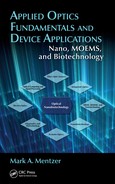Contents
1 Introduction to Convergent Disciplines in Optical Engineering: Nano, MOEMS, and Biotechnology
2.2 Optical Device Applications
2.2.2 GaAs Field Effect Transistor Technology
2.2.3 Optical Control of Microwave Devices
2.2.3.1 Optical Control of Active Devices: IMPATT Oscillators
2.2.3.2 Illumination Effect on IMPATT Diode Operation
2.2.3.3 Experimental Results on IMPATT Diodes: Optical Tuning
2.2.3.4 Noise Reduction by Optical Means
2.2.3.5 Optically Induced AM/FM Modulation
2.2.3.6 Optical Injection Locking
2.2.4.1 Illumination Effect on TRAPATT Operation
2.2.4.2 Experimental Results: Start-Up Jitter Reduction
2.2.4.4 Variation of Output Power
2.2.7 Optical Control of Passive Devices: Dielectric Resonator Oscillator
2.2.7.1 Illumination Effects on Dielectric Resonator Oscillator
2.2.7.2 Experimental Results: Optical Tuning
2.2.8 Applications of Optical Control
2.2.9 Future Needs and Trends iv Contents
2.3.4 Polarization Controllers
2.4 Applications of Fiber-Optic Systems
2.5 Optical Interconnects for Large-Scale Integrated Circuits and Fiber Transmission Systems
2.5.2 Link Design and Packaging
2.5.5 Large-Scale Integration Challenges
2.5.6 Advantages of Optical Interconnects
2.5.7 Compatible Source Technology
2.5.8 Receiver and Detector Technology
2.5.9 Integration of Sources and Detectors
2.5.10 Integrated Device Developments
2.6 Optical Interconnect Media
2.6.1 Guided Wave Interconnects
2.6.2 Single-Mode versus Multimode Fibers
2.6.4 Free-Space Interconnects
2.6.5 Holographic Interconnects
2.6.6 Guided Wave versus Broadcast Interconnects
2.7 Multiplexing and Demultiplexing: Information Distribution Techniques: WDM Schemes
2.8 Electro-Optic and Acousto-Optic Modulators
2.9 Assessment of Interconnect System Architectures: Optical Networking Architectures
2.9.1 Direct Relay Interconnects
2.10 Interconnect Risk Assessments
2.11 Electro-Optic System Applications
2.11.1 Special Application Lighting and Laser Illumination
2.11.2 Vertical Cavity Surface Emitting Lasers for Illumination
2.11.3 Spectral Matching Considerations
2.11.4 High-Brightness Imaging Contents v
2.12 Vertical Cavity Surface Emitting Laser Technology
2.12.4 High-Power CW and QCW VCSEL Arrays
2.12.6 Single-Mode VCSEL Devices
2.12.7 High-Speed VCSEL Devices
2.12.8 High-Brightness Arrays of Single-Mode Devices
2.12.9 Blue, Green, and UV VCSELs
2.12.10 Narrow Divergence Arrays
2.12.11 VCSEL-Based 1064 nm Low-Noise Laser
2.12.12 Low-Noise Laser Cavity
2.13 Derivation of the Linear Electro-Optic (Pockels) Effect
2.14 Nonlinear Refractive Index
3 Acousto-Optics, Optical Computing, and Signal Processing
3.2 Basic Bragg Cell Spectrum Analyzer
3.2.1 Components of Bragg Cell Receivers: Light Sources
3.3 Integrated Optical Bragg Devices
3.3.1 Fourier Transform, Fourier Transform Lens
3.4 Noise Characterization of Photodetectors
3.6 Photodetector Readout Techniques
3.7 Bulk versus Integrated Optic Bragg Cells
3.8 Integrated Optic Receiver Performance
3.9 Nonreceiver Integrated Optic Bragg Cell Applications
3.10.2 Interferometer and Quantum Well Devices
3.11.1 Description of the Quantum Well
3.11.2 Solution of the Exciton Energy
3.11.3 Determination of Ee and Eh
3.11.5 Effective Well Width Calculations and Computer Simulation
3.11.5.1 Matching of Wave Functions
3.11.5.3 Computer Calculations vi Contents
3.11.6 Summary of Calculation Procedure
3.11.7 Example: Fabrication of MQW Oscillator
3.12 Design Example: Optically Addressed High-Speed, Nonvolatile, Radiation-Hardened Digital Magnetic Memory
3.12.1 History of the Magnetic Crosstie Memory
3.12.2 Fabrication and Operation of the Crosstie Memory
3.12.3 Potential Optical Detection Scheme
3.12.4 Radiation Hardening Considerations
4.2 Amplitude Modulation Sensors
4.5 Fiber Acoustic/Pressure Sensors
4.6 Optical Fiber Characteristics
4.7 Fiber Transducer Considerations
4.8 Fiber Sensor Laser Selection
4.9 Laser Frequency Stability Considerations
4.10 Couplers and Connectors for Fiber Sensors
4.11 Fiber Sensor Detector Considerations
4.12 Fiber Magnetometer Applications
4.14 Fiber Sensor Signal Processing
4.14.1 Reference Phase Modulation
4.14.2 Fiber Sensor System Noise
4.15 Environmental Stabilization
4.16 Fiber Sensor System Design Considerations
4.17 Laser Diode Frequency Stability Considerations
4.17.2 Effect of Modulation and Modulation Depth on Mode Spectrum
4.17.3 Experimental Observations
4.17.4 Guided Index and DFB Laser Operation
4.17.5 Modulation Depth and Signal-to-Noise Considerations
4.17.6 Instability due to Optical Feedback from Distant Reflectors
4.17.7 Stability with Moderate External Feedback
4.17.8 Laser Frequency Stability Considerations in Fiber-Optic Sensors
4.17.9 Achieving Laser Stability through External Control Contents vii
4.17.10 Rare-Earth-Doped Semiconductor Injection Laser Structures
4.17.11 Solutions to Laser Frequency Instability: Summary
4.18 Fiber Sensor Design Example: Fiber-Optic Sonar Dome Pressure Transducer
4.18.1 Identification and Significance of the Problem
4.18.2 Possible Solution for a Sonar Dome Pressure Transducer
4.18.7 Single-Mode Fiber Directional Couplers
4.18.9 Reference Branch Phase Modulator
4.19 Design Example 2: Fiber-Optic-Based Laser Warning Receiver
4.19.5 False Alarms and Laser Discrimination
5.1 Planar Optical Waveguide Theory
5.2 Comparison of “Exact“ and Numerical Channel Waveguide Theories
5.3 Modes of the Channel Waveguide
5.5 Key Considerations in the Specifications of an Optical Circuit
5.5.2 Waveguide Building Block and Wavelength Selection
5.5.4 Material Growth: MOCVD versus MBE
5.5.5 Microwave and Electronic Circuit Compatibility
5.6 Processing and Compatibility Constraints
5.6.2 Substrate Specifications
5.6.3 Epitaxial Growth viii Contents
5.7 Waveguide Building Block Processing Considerations
5.7.2 Material Systems: Control of Loss, Refractive Index, and Electro-Optic Effect
5.8.1 Fiber to Waveguide Coupling
5.8.2 Waveguide to Fiber Coupling
5.8.3 Laser Diode to Waveguide Coupling
5.8.4 Waveguide to Detector Coupling
5.9 Lithium Niobate Technology
5.9.1 Electro-Optic and Photorefractive Effects
5.9.2 Photolithography and Waveguide Fabrication
5.9.3 Implantation and Proton Exchange Techniques
5.10 Semiconductor Waveguide Fabrication Techniques
5.10.2 Ion-Implanted Semiconductor Annealing
5.10.3 MOCVD: Growth and Evaluation
5.10.4 MBE: Growth and Evaluation
5.10.5 MBE Development in Space
5.11 GaAs Foundry Capabilities
5.12 Emerging Commercial Devices and Applications
5.12.2 Performance Testing Issues for Splitters
5.12.3 Passive Optical Interconnects
5.12.4 Configuration of a Curved Transition Waveguide
6 Optical Diagnostics and Imaging
6.3 Stability: Temperature and Time Effects
6.4 Measurement of ND(d) Using Capacitance–Voltage Technique
6.6 Spreading Resistance Profiling
6.8 Cross-Section Transmission Electron Microscopy
6.9 Infrared Reflectivity Measurements
6.10 Other Analysis Techniques
6.11 Biotechnology Applications Contents ix
6.12 Parametric Analysis of Video
6.12.1 Parametric Analysis of Digital Imagery
6.12.1.2 Real-Time Data Processing
6.12.1.3 Verification of FE Simulations
6.12.1.4 Complete Workflow in One Software Application
6.13.3 Typical System Requirements
6.13.4 Scintillators for Flash X-Ray
7 MEMS, MOEMS, Nano, and Bionanotechnologies
7.2.5 Advantages of MEMS and Nano Manufacturing
7.2.6.3 Fabrication Knowledge Required
7.3 Nanotechnology Applications
7.4 V-Groove Coupler Geometry and Design Considerations
7.5.3 Applications in Bioorganic Chemistry
7.5.3.2 Protein Structure and Folding and the Influence of the Aqueous Environment
7.5.3.3 Evolution and the Biochemistry of Life
7.5.3.4 Biochemical Analysis and Cancer
